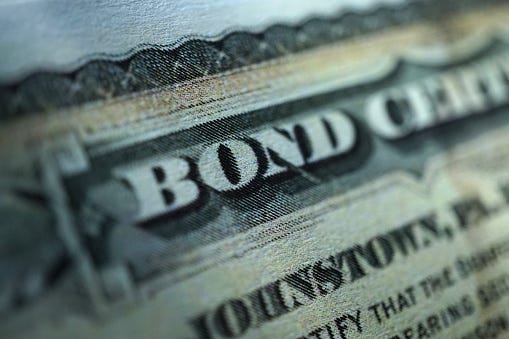Although risk-free U.S. government securities don’t sound like a worthwhile juicy returnable investment in a low-interest-rate environment, they may be more enticing than you think especially as inflation is nearing record highs in nearly 40 years!
There are a variety of treasury securities to choose from and one of the advantages to owning them is that they aren’t volatile. This is rare in the markets as everything is unpredictable. Having peace of mind is a rewarding feeling as an investor. If you can’t sleep at night, no matter how wealthy you are, you won’t feel truly rich.
As a fixed-income asset, treasuries are issued by the U.S. government. They are not only foolproof but one of the safest investments one could buy into since the U.S. has never defaulted on its debt. It has only continued to raise the debt ceiling to enormous amounts to not default on its loans. The government is a classic procrastinator.
Before we get into a special type of treasury security, let’s understand the various treasury options:
Treasury bills, or T-bills, are sold in terms ranging from a few days to 52 weeks. Bills are typically sold at a discount from the par amount (par amount is also called face value); rarely, they have sold at a price equal to the par amount.
Treasury notes, sometimes called T-Notes, earn a fixed rate of interest every six months until maturity. Notes are issued in terms of 2, 3, 5, 7, and 10 years.
Treasury bonds pay a fixed rate of interest every six months until they mature. They are issued in a term of 20 years or 30 years.
Treasury Inflation-Protected Securities, or TIPS, provide protection against inflation. The principal of a TIPS increases with inflation and decreases with deflation, as measured by the Consumer Price Index. When a TIPS matures, you are paid the adjusted principal or original principal, whichever is greater.
TIPS pay interest twice a year, at a fixed rate. The rate is applied to the adjusted principal; so, like the principal, interest payments rise with inflation and fall with deflation.
Although these are fantastic options for a guaranteed return over time, for a decent fixed rate, you need to wait quite a while plus since the rate is fixed, it might not be attractive during high-interest rate environments, only during a recession as investing in safeguarded investments are ideal at those times.
Let’s take a look at an ultra-popular investment that investors are obsessing about:
I Bonds (Series I Savings Bond)
I Bonds are issued by the U.S. government directly to retail investors. Compared to other treasuries, CDs, money market funds, and even bonds, I Bonds carry an attractive interest rate that adjusts to inflation.
Comparatively to TIPS (see above), I bonds are like a flexible-term variable-rate CD. You need to hold them on for at least 1 year and after that, you can cash out or can choose to hold them for up to 30 years.
Ultimately, I Bonds are helpful for short and long-term investing and since the value of the I Bond never goes down, the interest rate on your I Bond changes in six-month cycles, compared to a typical CD with a fixed interest rate for the term.
Every six months there is a new rate in which is guaranteed to match inflation! If inflation is higher, the interest rates on your I Bonds automatically go up.
When you purchase the bonds, the interest rate doesn’t change right away when a new rate hike is announced. Each bond stays with the same previous rate for the full six months until it moves to the next rate.

Taxes Due
Once you cash out, you receive all the accumulated interest payments. Since the interest on I Bonds is credited monthly and automatically reinvested every six months, you receive payment then. You only pay tax on the interest when you decide to cash out as opposed to needing to pay taxes on the interest of any ordinary bond or CD every year.
A bonus about I Bonds is that it is exempt from state and local income taxes. Not only do you have the tax deferral, but the exemption as well!
Until you redeem (cash out) any I Bonds in any year, you won’t receive a 1099 form for the interst earned. As with every investment, you only pay taxes on realized gains (sold).
Purchasing
I Bonds are an appealing investment choice as the current guaranteed annualized interest return rate of 7.12% in the first six months and afterward, the rate will continue to match inflation from the previous six months.
If you do choose to move forward with this investment, there are only two ways to buy I Bonds.
You can either go through the TreasuryDirect.gov website which is the easiest or you can use money from a tax refund when you file your tax return. They are not available through tax-advantaged accounts such as a 401k, Roth IRA, IRA, HSAs, FSA, etc. nor through an outside brokerage such as Vanguard or Fidelity.
When purchasing I Bonds, you can only use after-tax money. On the TreasuryDirectgov website, the limit is $10k each calendar year per SSN as the primary owner in a personal account. Using money from a tax refund, the limit is $5k.
With sky-high hyperinflationary rates, there is no better time to take advantage of it and lock it in than today before the Fed stops its bond-buying program in March and hikes 3 times next year. This past week my family and I purchased I Bonds within our trust account as well as within our individual accounts up to $40k. We plan on doing the same thing in about 2 weeks into the new year as one can buy up to $10k per calendar year in multiple accounts!
If you have a trust, business, or even kids under 18, you can also buy $10k each of I Bonds in a custodial account for your kids. Plus remember to gift them a tax-free gift of $16k next year to invest!
A married couple each with a trust and business can buy up to $65k each calendar year. Although 7% isn’t ~25% as the S&P 500 has seen this year, it still is something GUARANTEED, and considering the markets as a whole, it isn’t bad. Equities only returned roughly 10% in the past 2 decades anyway.
Who knows how next year will turn out. GDP forecasts and equity returns aren’t looking as frothy so getting a GUARANTEED return is enough for many people. There’s rarely anything guaranteed in the markets besides volatility, speculation, gambling, and insanity. Since that is normal for the markets I guess you could say we had a normal year.

How To Open An Account
I promise you — it will take as long as opening a Robinhood account.
Go to Treasurydirect.gov and click on the top right, open account. You will need to choose an option for individual/personal, trust, or business account. Then fill out the required information, choose a security image, password, and answer the security questions.
Something to note, the TreasuryDirect website only allows individual accounts. Although each member must have their own separate account, you can specify an owner or beneficiary on the bonds in your account.
After completing all the security questions and personal information, it’s time to schedule a purchase. Once you create a password, you have the option to buy these various securities which are all listed on their site:
Marketable securities:
Bills — Short-term securities of 1 year or less
Notes — Medium-term fixed-principle securities of 2–10 years
Bonds — Long-term fixed-principal securities of more than 10 years
TIPS Notes/Bonds — Medium or long-term Treasury Inflation-Protected Securities of 5–30 years
FRN — Medium-term Floating Rate Notes
Savings Bonds:
Series EE- An accrual-type security with a fixed interest rate
(THIS IS IT) I BONDS Series I — An accrual-type security with a combo interest rate of a fixed and an inflation rate
Zero-Percent Certificate of Indebtedness
C of I — A non-interest bearing security which can be used to fund TreasuryDirect purchases
Something to note, The TruasyrDirect doesn’t send any account statement. You need to check your balance on the website under ‘Total Principle Value’ when log in on the homepage.
As time in the market beats timing the market, especially with fixed-income securities which are notorious for their wait times, I Bonds are best to keep for as long as you can.
If you can’t beat ’em (inflation) join ’em. There’s a reason I Bonds have a purchase limit and no joint account. They are too enticing not to tap into with a guaranteed inflationary adjusted rate. Don’t succumb to inflation, buy into it before it’s gone!

